(VIP Introduction omitted)
Dharma Discourse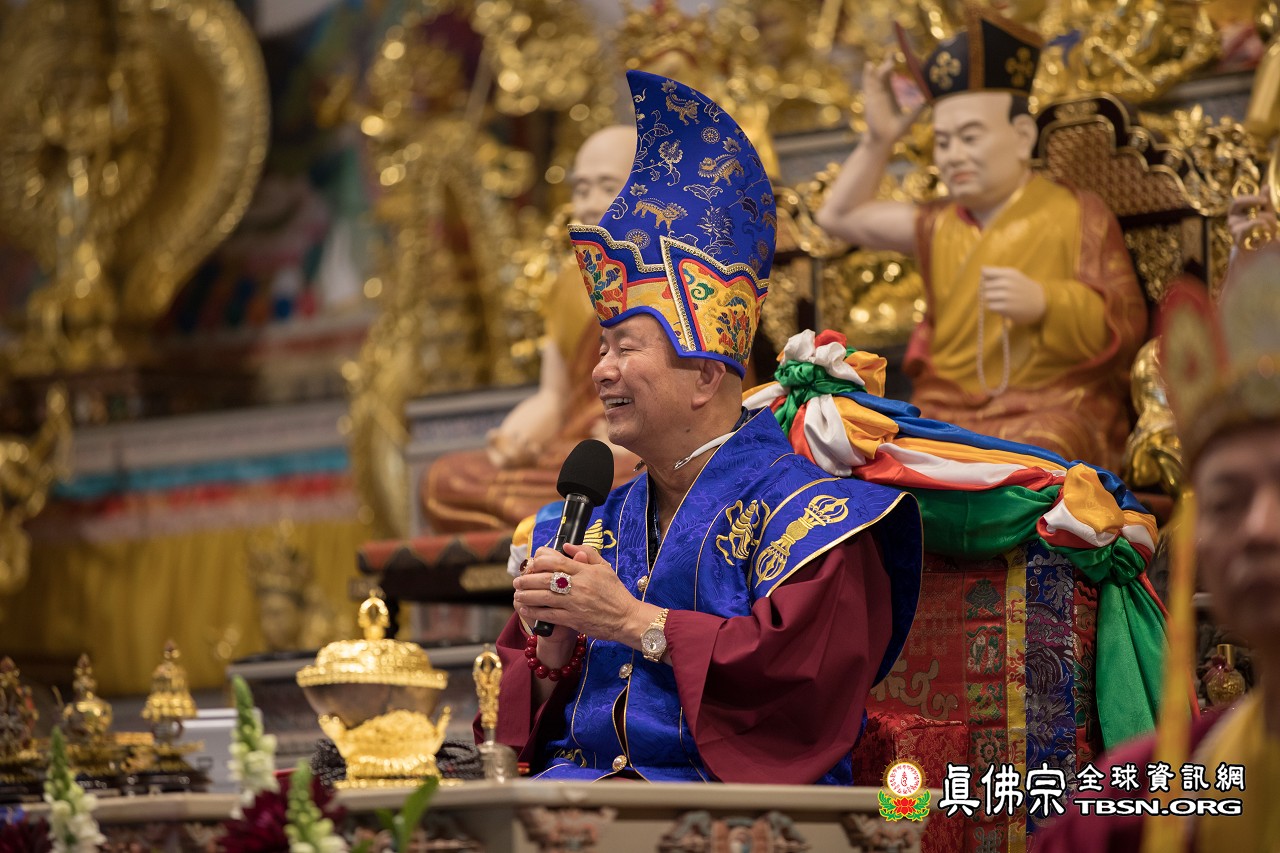 Let us first pay homage to Reverend Liaoming, HE Sakya Zhengkong Rinpoche, HH the Sixteenth Karmapa, Vajra Acharya Thubten Dargye, the Three Jewels at the Shrine, Machig Labdron, and Black Wrathful Dakini.
Let us first pay homage to Reverend Liaoming, HE Sakya Zhengkong Rinpoche, HH the Sixteenth Karmapa, Vajra Acharya Thubten Dargye, the Three Jewels at the Shrine, Machig Labdron, and Black Wrathful Dakini.
Shimu, Thubten Siddhi, masters, senior reverends, reverends, Dharma instructors,Dharma assistants, chairpersons of local chapters, fellow Dharma brothers and sisters here today and online, and our guests of honor: Thank you for coming. Greetings to everyone. (Grand Master greets everyone in various languages).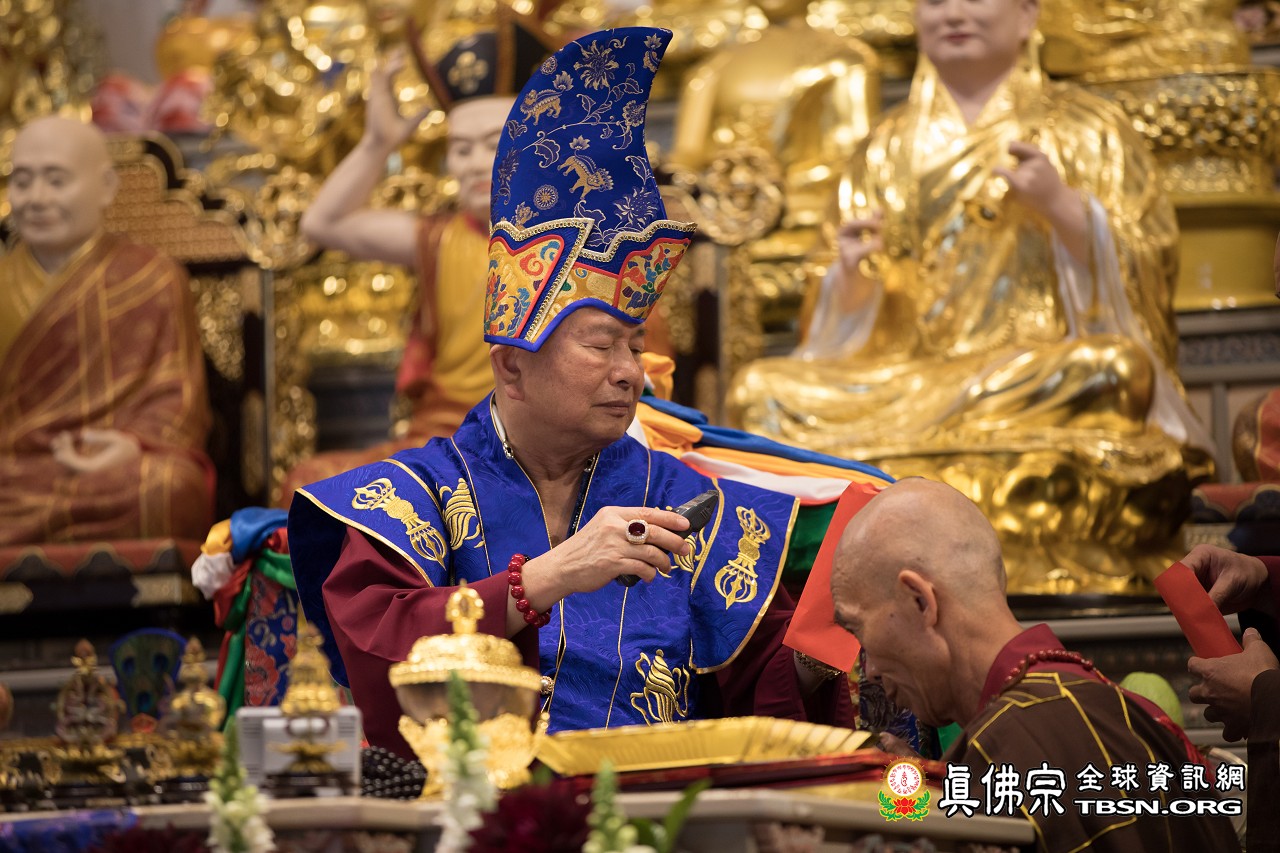 100,000 Machig Labdrons and 100,000 Black Wrathful Dakinis (Troma Nagmo) descended. In intense, brilliant light, they performed the most wild, beautiful, and captivating dance imaginable
100,000 Machig Labdrons and 100,000 Black Wrathful Dakinis (Troma Nagmo) descended. In intense, brilliant light, they performed the most wild, beautiful, and captivating dance imaginable
Today, I am very happy. Let's welcome Machig Labdron. Just as I lit the homa fire, 100,000 Machig Labdrons and 100,000 Black Wrathful Dakinis (Troma Nagmo) descended. The Machig Labdrons, who were white in color, danced in red hot fire while holding fiery, flaming red damarus and vajra bells. The Machig Labdrons were not holding a khatvanga (authority staff), although the Black Wrathful Taras were. All the khatvangas were on fire. They were aflame in flames of red fire.
Upon their descent, the 100,000 Machig Labdrons and 100,000 Troma Nagmos danced. The entourage was majestic, and the dance was something I'd never seen before. The dancing matched the fire in its fury and wild abandon; it was hotter than a belly dance. I've never seen such wild and fiery dancing.
When setting the boundary to start the homa, Grandmaster Lu and Black Wrathful Dakini became one. Troma Nagmo taught the Chod Practice
Just now when I lit the homa fire, I saw Black Wrathful Dakini. The moment I set the homa boundary with the vajra staff, Troma Nagmo descended. She immediately severed my head, arms, and legs with a kartika, then threw the pieces into the homa fire. She lifted my torso and threw that into the fire as well. In an instant, I was entirely immersed in fire! Troma Nagmo told me this was her teaching of the Chod Practice. After burning up, I circumambulated one time, returned to my Dharma seat, sat down, and transformed into Machig Labdron. The mudras I formed included those of Machig Labdron and Troma Nagmo.
Those attending this ceremony today are truly fortunate. As for those who attended the ceremony but left early, I can only say xxxx. Not xxx, but xxxx. Four x's aren't as bad as three x's, which would be a scolding. I won't say anything further.Those acharyas who attended today's ceremony are truly fortunate. I will say nothing further about those acharyas, reverends, and disciples who did not attend the ceremony. It is what it is.
My point is, the teaching of Machig Labdron and her Chod Practice is rarely heard. This is the one and only opportunity because after today, I will no longer discourse this practice or bestow empowerment for it. If one wants the empowerment, one will have to find another vajra master who has received the empowerment to bestow it. From this day on, receiving or bestowing the empowerment for this practice is not any of my concern. I will discourse this practice this one time, and that's it.
The first objective of the Chod Practice is giving: one offers one's body to the 10 Dharma realms, karmic creditors, and the four maras
One seldom encounters the Chod Practice, although one may see it on the internet. The video we watched only introduced the practice and described how to perform it. Of most importance is capturing the essence of the practice. There are three major objectives of the practice. Actually, there are four.
The first is giving. When one gives one's body as an offering, one's body transforms into red and white ambrosia. This ambrosia is offered to the 10 Dharma realms consisting of the four holy realms and the six realms of transmigration, one's karmic creditors, and the four maras. They are all included in the offering one makes. This is giving, the first major objective. It's not easy to please all the 10 Dharma realms consisting of the four holy realms and the six realms of transmigration, one's karmic creditors, and the four maras. Remember, the first objective is giving.
The second major objective of the Chod Practice is no-self, annihilation of self-grasping and eradication of afflictions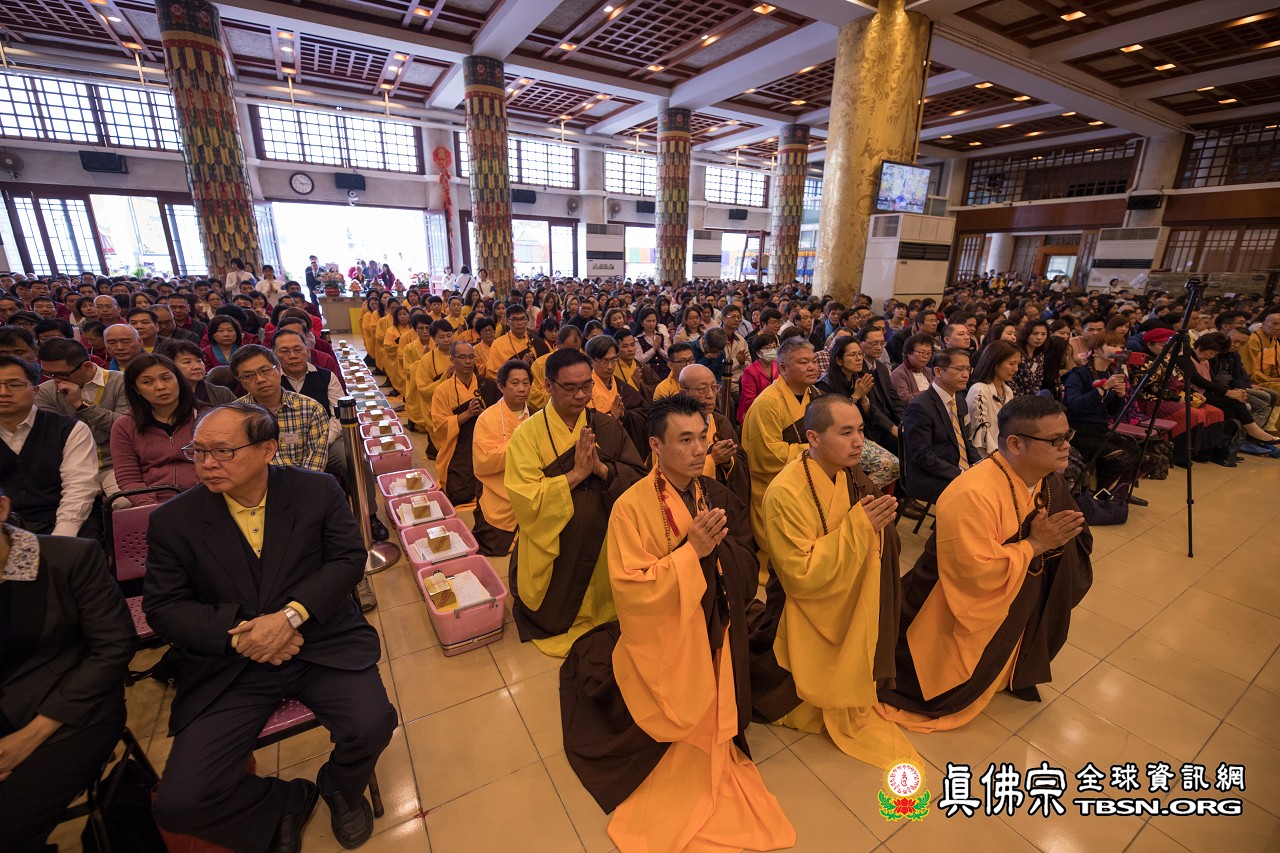 After the first objective of offering one's body, I will point out the second objective. The sacrifice of one's entire body is no-self. Many of you took the bodhisattva vows today. When I was discussing the bodhisattva precepts just now, I was, in fact, discussing the cultivation of non-self.
After the first objective of offering one's body, I will point out the second objective. The sacrifice of one's entire body is no-self. Many of you took the bodhisattva vows today. When I was discussing the bodhisattva precepts just now, I was, in fact, discussing the cultivation of non-self.
In the past, the Buddha discoursed how difficult it is to annihilate self-grasping. Why does self-grasping, gratitude, resentment, love, and hatred exist in sentient beings? I have this to say: gratitude, resentment, love and hate exist because of self-grasping. When one has offered one's body completely, when there is no longer any ''self,'' how can there be any self-grasping? There is no existence, no trace of self-grasping left.
The principle is quite simple; one must annihilate self-grasping. Because of self-grasping, one experiences gratitude, resentment, love and hate. These thoughts, feelings, and self-grasping are from oneself. When one has mastered Machig Labdron's Chod Practice, which burns one's body up entirely and make an offering of it, self-grasping naturally disappears. Do you agree?
When one's body is dead, where is gratitude, resentment, love and hatred? If there is no ''self'', will one still have afflictions? When the body is gone, that is, burned up, when all is given to Machig Labdron and the 10 Dharma realms, where are afflictions? When there is no ''self'' where are afflictions? Afflictions exist because human beings have the concept of self. In the absence of ''self'', afflictions do not exist.
This is the inner meaning of the second objective. The outer meaning is represented by offering one's body. The inner meaning is annihilation of self. No-self and self-grasping, all disappear.
The third objective of the Chod Practice is emergence of the primordial pure brilliance and merging with it to attain Buddhahood
The key meaning of the third objective is the emergence of primordial pure brilliance. One is able to see one's Buddha-nature, that is, one sees one's primordial pure brilliance.
In summary, this practice has three major objectives. The first is giving; the second is annihilation of self-grasping and afflictions; the third is the emergence of primordial pure brilliance. By cultivating Chod Practice, one's primordial pure brilliance will swiftly manifest. When one finally sees one's primordial pure brilliance and merges with it, one attains Buddhahood.
The practices of Machig Labdron and Troma Nagmo require empowerment. Without empowerment one may not perform these practices
What I am discussing today is simple and easy to understand. After receiving the empowerment and cultivating the practices of Machig Labdron, Troma Nagmo, and Chod, one can easily attain Buddhahood. However, those who don't receive the empowerment because of leaving early or being absent may not cultivate the practice.
Just now, everyone watched a video describing the cultivation sequence of Machig Labdron Practice. Without the empowerment, one may not cultivate the practice. Those acharyas, reverends, and disciples who don't receive the empowerment may not cultivate this practice unless they come to Seattle and request the empowerment in person. Even so, I won't discourse this dharma again. One has to receive the empowerment in person in Seattle, not in Taiwan. I will not transmit this practice anymore. As I just stated, I will not transmit it again. Great Affinity with Machig Labdron and Troma Nagmo
Great Affinity with Machig Labdron and Troma Nagmo
I have great affinity with Machig Labdron and Troma Nagmo. In my bedroom at the True Buddha Tantric Quarter in Seattle, I have a thangka of Machig Labdron.
As for Troma Nagmo, I have a painting of her made by Elizabeth. Originally, Elizabeth gave the painting to Master Huijun, but Master Huijun didn't feel she had an affinity with Troma Nagmo. (Master Huijun objects.) What do you mean? You do have affinity? You do like Troma Nagmo? (Master Huijun: Yes! Very much!). If you like the painting so much, why did you give it to me? (Master Huijun: I make offerings of my favorite things to Grandmaster). I see. You offered your favorite thing to me. You have the gift of the gab.
Originally, Elizabeth made a drawing of Troma Nagmo for Master Huijun. (Master Huijun: I asked her to make it for me). Ok, she asked Elizabeth to draw it for her. When Huijun received it, she gave it to me. I then hung it on the wall next to my table in my home office in Taiwan. Am I right, Master Huijun? (Master Huijun: Right!)
Therefore, I have a real affinity with Machig Labdron and Troma Nagmo. Today, 100,000 Machig Labdrons and 100,000 Troma Nagmos came to Taiwan Lei Tsang Temple. It's everyone's great good fortune to be here!
I have discoursed the essence of the practice, but do you know how to cultivate it? Machig Labdron is beautiful. Her right hand holds a damaru while her left hand holds a vajra bell. She stands on her left leg atop a lotus, while elevating her right leg. She rings the vajra bell and plays the damaru while standing in dancing posture.
Machig Labdron's pure land is Aoming Heaven, a pure land for dakinis. The mantra used by True Buddha School is different from that used by Tibetans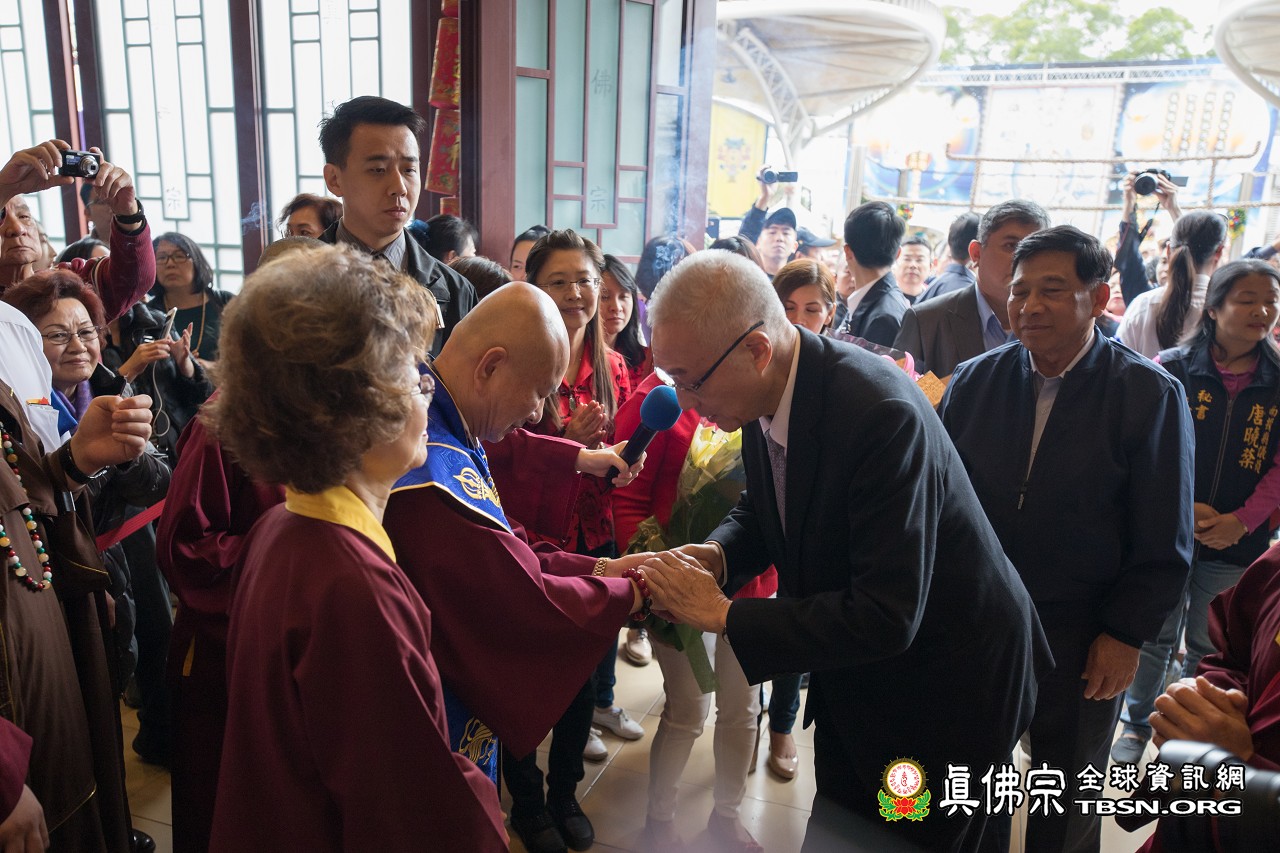 The mantra is ''Om, beh-dza, ma-ji-lah, xia-xia, hum, hum, pei''. The True Buddha School mantra differs somewhat from the mantra used by other schools. The mantra we use is ''Om, beh-dza, ma-ji-lah, xia-xia, hum, hum, pei''. ''Xia-xia, hum, hum, pei.''
The mantra is ''Om, beh-dza, ma-ji-lah, xia-xia, hum, hum, pei''. The True Buddha School mantra differs somewhat from the mantra used by other schools. The mantra we use is ''Om, beh-dza, ma-ji-lah, xia-xia, hum, hum, pei''. ''Xia-xia, hum, hum, pei.''
The mantra used by Tibetans is ''Om beh-dza, mah-ji-lah, che-che, qie-qie, hum, hum, pei.'' Qie-qie, qie-qie, qie-qie, qie-qie-qie-qie, hum, hum, pei. They chant ''qie-qie'', ''qie-qie'', which is interesting. The syllables, ''qie-qie'' mean ''to cut off''.
How about our ''xia-xia''? It means a swift, cutting action resulting in instant severing, that is ''xia-xia, hum, hum, pei''. Hence, her mantra is ''Om, beh-dza, ma-ji-lah, xia-xia, hum, hum, pei''. The mantra we chant in the True Buddha School is different from the Tibetans who chant ''qie-qie''.
So, we have the image, mantra, and the mudra of the dakini. Why do we use the dakini mudra? Because Machig Labdron is a dakini. Machig Labdron also comes from Aoming Heaven. The Aoming Heaven is the pure land for dakas and dakinis.
Machig Labdron's mudra is the same as Jade Pond Golden Mother. With mudra, image and mantra, one can begin cultivating the Machig Labdron Practice.
The cultivator's white drops in the brow chakra are from the father. The red drops in the navel chakra are from the mother
What I want to discourse primarily is how to cultivate Troma Nagmo Practice. Although you have already learned the practice from the video, let's watch it one more time.
(Video plays)
Please remember the cultivation sequence described in the video. The fact is, everyone's body already has white and red drops. The white drops in the brow chakra come from the father's side. The red drops in the navel chakra are from the mother's side.
After being burned up in the fire, we transform into red and white ambrosia. The kapala [skull cup] is entirely filled with red and white ambrosia. This ambrosia is actually the red and white drops in our body. The entire body is given as an external offering. The internal offering is annihilation of self-grasping and all afflictions.
Merely wishing for good fortune is not the true meaning of this practice. The true meaning of the practice is the emergence of one's primordial pure light after the annihilation of self-grasping and eradication of afflictions. The primordial pure light is actually one's Buddha-nature. Therefore, it means one's Buddha-nature will emerge.
In Vajrayana cultivation, the sequences outlined in Lamdre place utmost importance on the practice of inner fire. Use the inner fire to burn one's body, thereby burning up self-grasping, afflictions, and habitual karmic patterns in their entirety. What is the extent of this burning up? In fact, the inner fire can entirely burn one's body, thus totally annihilating the ego.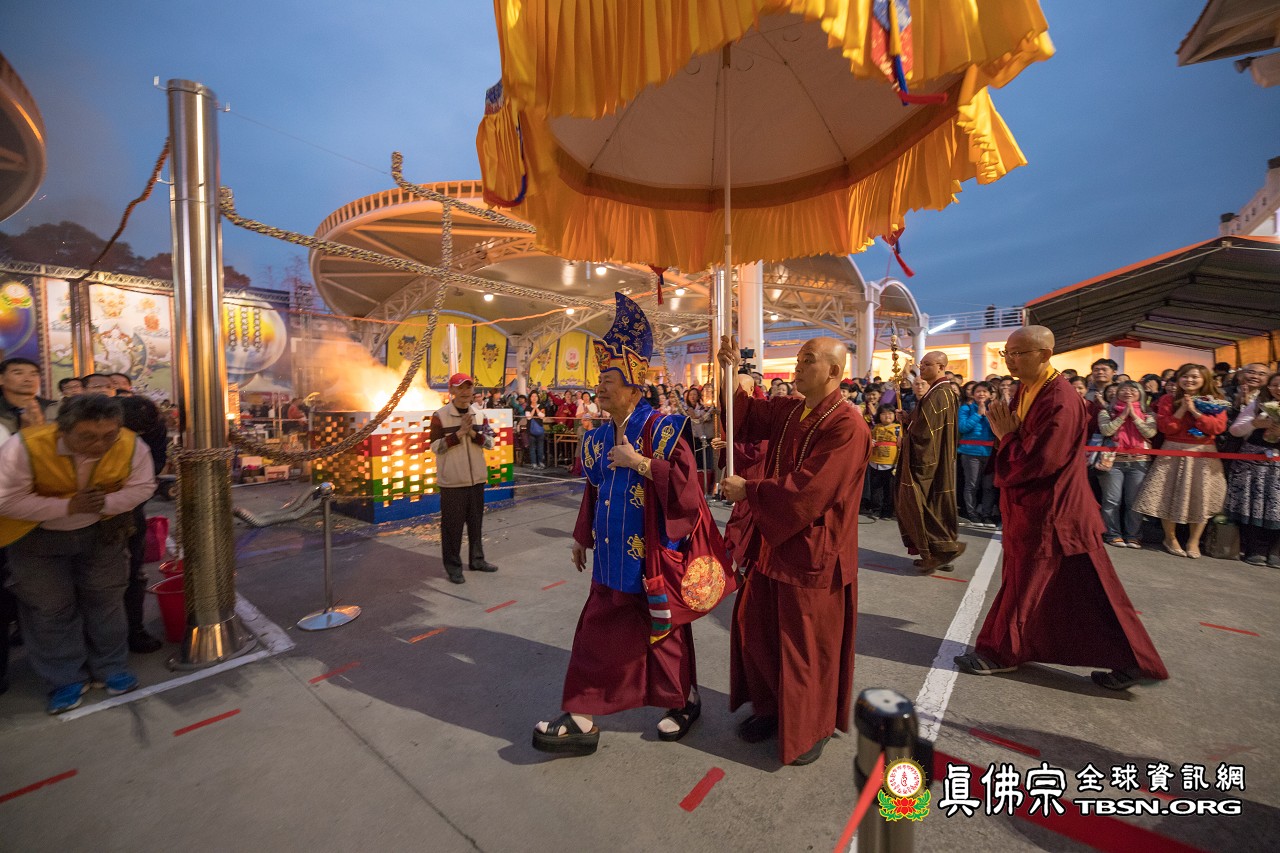 Troma Nagmo is an emanation of Machig Labdron. The human lineage is Lama Sonam of the Shije Sect and Padampa Sangye of the Joyul Sect
Troma Nagmo is an emanation of Machig Labdron. The human lineage is Lama Sonam of the Shije Sect and Padampa Sangye of the Joyul Sect
The most critical common denominator of Hevajra and Lamdre practices is activation of inner fire, whereby one's entire body is naturally burned into nothingness and becomes no-self. Today's Machig Labdron Practice and Troma Nagmo...Troma Nagmo is namely an emanation of Machig Labdron.
So, what is the background of Machig Labdron? She was born in Tibet. When she was young, Machig Labdron and her sister studied Buddhadharma with Lama Sonam. During this period, they learned the four empowerments of Dorje Pakmo and the practice of samadhi from Lama Sonam.
Machig Labdron holds two lineages. One is called the Shije Sect [zhi-byed in Tibetan]. What Machig Labdron learned at first was the dharma of the Shije Sect. It was only later that Machig Labdron met Padam Sangye, the Bodhidharma of Chinese legend, when he travelled to Tibet. The Tibetans added a ''pa'' to his name, hence, Padam Sangye is also known as Padampa Sangye. (Master Lian-wang, am I right?) Oh. He is also known as Dampa Sangye. No matter - it can be either Padampa Sangye, Padam Sangye, or Dampa Sangye. It's only a name.
The space lineage of Machig Labdron comes from Prajnaparamita Buddha Mother and Dorje Pakmo
Padam Sangye founded the Joyul [gcod-yul] Sect. In Tibet, very few females became accomplished great adepts. Machig Labdron, however, was a great adept. Hence, Padam Sangye transmitted the dharma of the Joyul sect to her when they met. Upon encountering Machig Labdron, Padam Sangye perceived that she possessed the four types of wisdom, great wisdom. Padam Sangye perceived that she was from a lineage which descended directly from Prajnaparamita Buddha Mother and all dakinis to Dorje Pakmo. Dorje Pakmo is above Machig Labdron, and Prajnaparamita Buddha Mother is above Dorje Pakmo. Dorje Pakmo was Machig Labdron's guru.
Chod practice is the Dharma gate of practicing death
Machig Labdron mastered the four types of wisdom. Her Chod Practice is the most well-known. Everyone here today will receive empowerment for the Chod Practice and may cultivate it. In this practice, one perceives oneself as actually dead.
I myself practice death everyday. I practice this because, when one is dead, all attachments are terminated. When one is dead, what social status is there to grasp at? One no longer grasps. Just now, many people got married...Shimu and I have an exceptionally good relationship, which is quite unusual. Shimu and I are 100% good to each other. I am willing to accompany her in old age; or if I should depart earlier than her, she will accompany me in old age. You know, even now whenever I see Shimu my heart trembles like a baby deer.
When I see girls such as Lei Qian, Li Qi, and Yiting, I will also tremble like a little deer. I am always 20 years old. Let me tell you. I always practice my death. Even though I am only 20 years old, I still practice my death. I am unaffected by the external environment, because for me, there is no external environment, nor is there an ''I''. Therefore, I clearly understand that the trembling in my heart is unreal.
Tomorrow, we will be at Linkou Stadium and I will discourse the Huayan (Avatamsaka) Three Views: the Empty View, the False View, and the Middle View. The Huayan Three Views are advanced concepts; in fact, the Middle View Dharma can lead to an extremely high level of attainment. Once you enter the Middle View and death, there is actually neither life nor death. Life and death merge in harmony with each other. I will explain this in detail tomorrow.
Joyul Dharma annihilates self-grasping and terminates reincarnation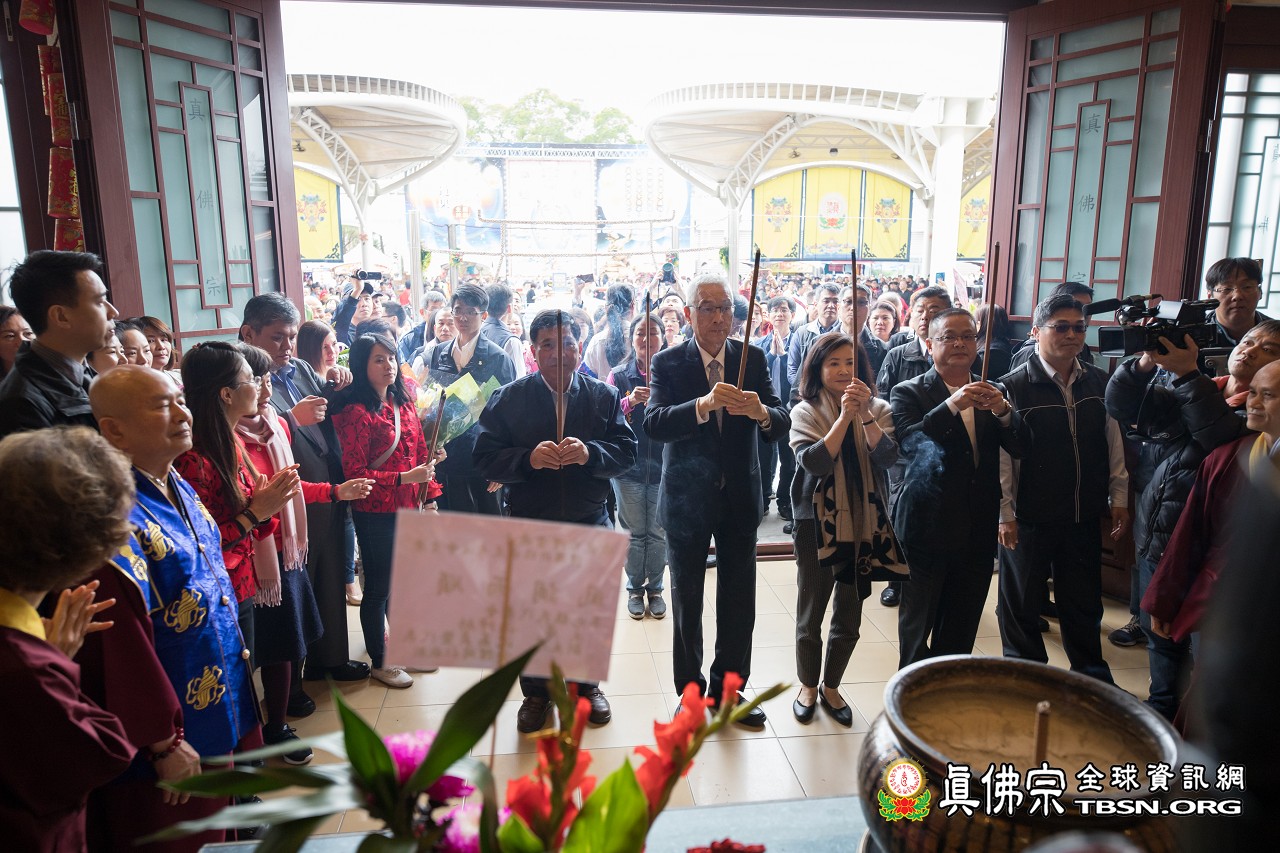 Why do I want to specially talk about death today? Because in Joyul (gcod-yul) Dharma, the important idea is to cut or sever. What does sever mean? Neither life nor death have any affect on one. Once one is dead, everything is severed; everything is cut off. Most importantly, one does not reincarnate. Why does one reincarnate? One reincarnates through the force of self-grasping, gratitude, resentment, love, and hatred! If this force is strong, one must reincarnate!
Why do I want to specially talk about death today? Because in Joyul (gcod-yul) Dharma, the important idea is to cut or sever. What does sever mean? Neither life nor death have any affect on one. Once one is dead, everything is severed; everything is cut off. Most importantly, one does not reincarnate. Why does one reincarnate? One reincarnates through the force of self-grasping, gratitude, resentment, love, and hatred! If this force is strong, one must reincarnate!
What does it mean to sever? My body is not mine. My head is not mine. My thoughts and ideas are not mine. My heart and mind are not mine. What, then, is yours? Nothing is yours. Because nothing is yours, you attain Buddhahood.
So, forget about reputation! What is even there to be called reputation? There is no reputation. What are insults and slander? Buddhism talks about eight winds* [eight worldly concerns]. Just let it all go. When one is dead, what is there to cling to? [*The eight winds refer to the four favorable circumstances of prosperity, honor, praise, and pleasure, and the four setbacks of decline, disgrace, censure, and suffering.]
Even wealth is useless. You cannot use it in heaven. One could burn some True Buddha joss paper, that might be of use! As for wealth and sexual desire, once one is gone, where is sexual desire? Beauty and ugliness are one and the same. Just because one is fat doesn't mean one is ugly. Lady Yang Guifei of the Tang Dynasty, for example, was fat yet not repulsively so. She was, in fact, beautiful. Actually, all the Tang Dynasty beauties were inclined to be heavy. Whether one is on the fat side or the thin side has nothing to do with being beautiful or ugly.
And how about social status? The emperors of different dynasties all had high status, right? Emperors started all the way from Xuanyuan, the Yellow Emperor of the Shen-nong clan.
We are called Yan Huang descendents - that is, we are descendents of the Yan (a.k.a. Shen-nong clan) and Huang which refers to Yellow Emperor. So where is the Yellow Emperor? The Yellow Emperor of the Xuanyuan clan is in Emperor Temple in Taiwan.
Yan Huang descendents became the dynasties of Tang, Yu, Xia, Shang, Zhou, Qin, Han, the Three Kingdoms as well as the dynasties of Wei, Jin, North and South. We also had the dynasties of Sui, Tang, Song, Yuan, Ming, Qing followed by the modern Republic of China (ROC) and the People's Republic of China (PRC). Which emperor is not great? However, let me ask you. How many emperors do you remember? Not one.
We only know that during the Tang Dynasty, there was the Prosperity of Zhenguan; in the Han Dynasty, there was the Prosperity of Wen and Jing. In the present-day, we have to decide who to elect. We should choose a president who has the welfare of the people at heart. We shouldn't elect a president who cares only about his or her own authority while ignoring the welfare of the people. So when we vote, we should choose someone who can accomplish things and look after the well-being of the people. This is very important. When you evaluate the candidates running for president of Taiwan, one won't go wrong if one chooses someone who can accomplish things for the people.
Here's a joke. A wife is bathing and suddenly screams, ''Husband, there is a peeping Tom outside peeking at me!'' Husband said, ''Really? He then quickly opens the windows.'' The wife angrily exclaims, ''You're crazy!'' The husband says, ''Let him see you clearly. That way he won't want to peep at you in the future.''
Let me tell you. The same thing applies once you get married. But I will tell you, there is nothing to see. If you are dead, and your spirit still sees, you will be reincarnated. Because there is nothing, at that time, one's true death is actually a true birth.
When meeting a person one likes, one must be bold enough to declare one's love; if one is rejected, it may not be because one is mediocre, but rather because one is unattractive. This is based on the ''visual'' sense. A dead person wouldn't experience this. Please forgive those who have hurt you. The first time you are hurt is just because you are infatuated. The second time you will tolerate it. When comes the third time, one will be used to it. One's death is not a habit, because in death there are no habits.
Marriage is not the graveyard of love, as some claim. When everyone's experience is the same, then marriage is like a cemetery. So no matter what, at that age when one ''dares to love and hate,'' have an extraordinary relationship. Have no fear of loving wrongly; only fear losing the chance to love at all. If that happens, your mother will have to arrange matchmaking for you.
Here's another joke. A granddaughter asked her grandfather, ''Why does grandpa write in the book that life begins at 70?'' The grandfather replied, ''That is when you begin having arthritis, diabetes, presbyopia, and strokes.'' Let me tell you: if you constantly visualize yourself as dead, then you and your sickness will become friends, and you won't have any sickness. If one is dead, where is sickness?
Laozi once said: ''Having this body is my calamity. My life's troubles are mainly due to my body.'' At the time, Laozi didn't know about Machig Labdron Practice. Had he known about the Chod Practice, he wouldn't have even had a body.
An old man went to see the doctor and told him, ''My memory is very poor. I can't remember where I live or what my name is, and I forgot to pay for my meal at a restaurant. I can't even remember my wife's name.'' The doctor asked, ''When did the problem begin?'' The old man replied, ''Did you ask me what problem I have? What is this?! I don't have any problem at all.'' The old man couldn't even remember that he had any illnesses. He had forgotten what he just told the doctor.
Here is a phenomenon I recently experienced. Before brushing my teeth, I rinse my mouth with water. Then I brush my teeth with a toothbrush and use dental floss. After that, I use an electric toothbrush for final cleaning.
Now I have a problem. After I finish brushing the upper teeth and proceed to the bottom row, I forget whether I brushed the upper row after finishing with the lower row. So I brush the upper row again. By then I've forgotten whether I brushed the bottom row. As a result, my brushing routine always takes a long time. Please forgive me. I'm really forgetful. So, next time you see me eating, the moment I pick up the chopsticks you must remind me, ''Grandmaster, please do offering first.''
However, no worries. Why? Because once one is dead, or has performed the Chod Practice, everything is gone. There is not even ''forget'' or ''remember''.
Thank you. Om mani padme hum!
True Buddha Dharma-character Treasury - Machig Labdron
2019-02-23 HH Living Buddha Lian-sheng Sheng-yen Lu Instructs Machig Labdron Mantra
2019-02-23 HH Living Buddha Lian-sheng Sheng-yen Lu Instructs Machig Labdron Mudra
20190223 Machig Labdron Fire Offering Ceremony by Grand Master Lu-TBSN HD
20190223 Debut Transmission of Machig Labdron Practice and Chod Practice by Grand Master Lu-TBSN HD
20190223 20190223 Visualization Video of Machig Labdron Practice with Chinese/English subtitles by Taiwan Lei Tsang Temple
Debut Transmission of Machig Labdron Practice, Grand Jihai Year Spring Blessing Homa Ceremony
Translated by True Buddha Translation Team
Translator: Jessie Loh
Editors: Henry Wolf and DJ Chang




